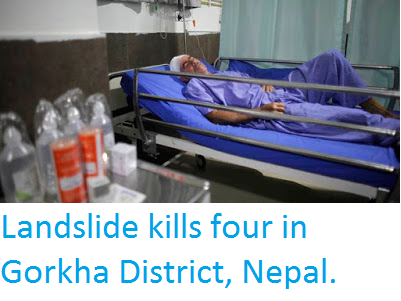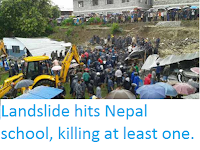Seventeen people have been confirmed dead and another three are missing after a series of landslide and flash floods across Nepal in the last two days. Four people, including a five-year-old child, have died in separate flood-related events in Banke district, while in Rolpa, a landslide destroyed a house, killing an eight-month-old baby, her 22-year-old mother, and a fifteen-year-old boy, and another landslip in Baglung killed a six-month-old baby and both parents.. In Kailali a 65-year-old-woman died when her house collapsed amid heavy rains, her husband was injured in the same incident and is being treated in a local hospital. Four students were swept away by floodwaters in Parsa District, two of whom were rescued, with one confirmed dead and one still missing. Two people were swept away by floods in Sarlahi District, one of whom has now been confirmed dead and one is still missing. Another person is missing after being swept away by a flood in Tanahun District.
The remains of a bridge swept away by floodwaters in Baglung District, Nepal, on Monday 23 June 2018. Kathmandu Post.
The incidents have been blamed on torrential rainfall that has fallen across the country in the last few days. Landslides are common during the monsoon season in Nepal, which lasts from May to September, with the highest rainfall occurring in July. Landslides are a common problem after severe weather events, as excess pore water pressure can overcome cohesion in soil and sediments, allowing them to flow like liquids. Approximately 90% of all landslides are caused by heavy rainfall. Landslides and floods are a problem in Nepal every monsoon season, with over 1600 people having died in such events since 2010.
Monsoons are tropical sea breezes triggered by heating of the land during the warmer part of the year (summer). Both the land and sea are warmed by the Sun, but the land has a lower ability to absorb heat, radiating it back so that the air above landmasses becomes significantly warmer than that over the sea, causing the air above the land to rise and drawing in water from over the sea; since this has also been warmed it carries a high evaporated water content, and brings with it heavy rainfall. In the tropical dry season the situation is reversed, as the air over the land cools more rapidly with the seasons, leading to warmer air over the sea, and thus breezes moving from the shore to the sea (where air is rising more rapidly) and a drying of the climate. This situation is particularly intense in South Asia, due to the presence of the Himalayas. High mountain ranges tend to force winds hitting them upwards, which amplifies the South Asian Summer Monsoon, with higher winds leading to more upward air movement, thus drawing in further air from the sea.
Diagrammatic representation of wind and rainfall patterns in a tropical monsoon climate. Geosciences/University of Arizona.
See also...
Follow Sciency Thoughts on Facebook.








